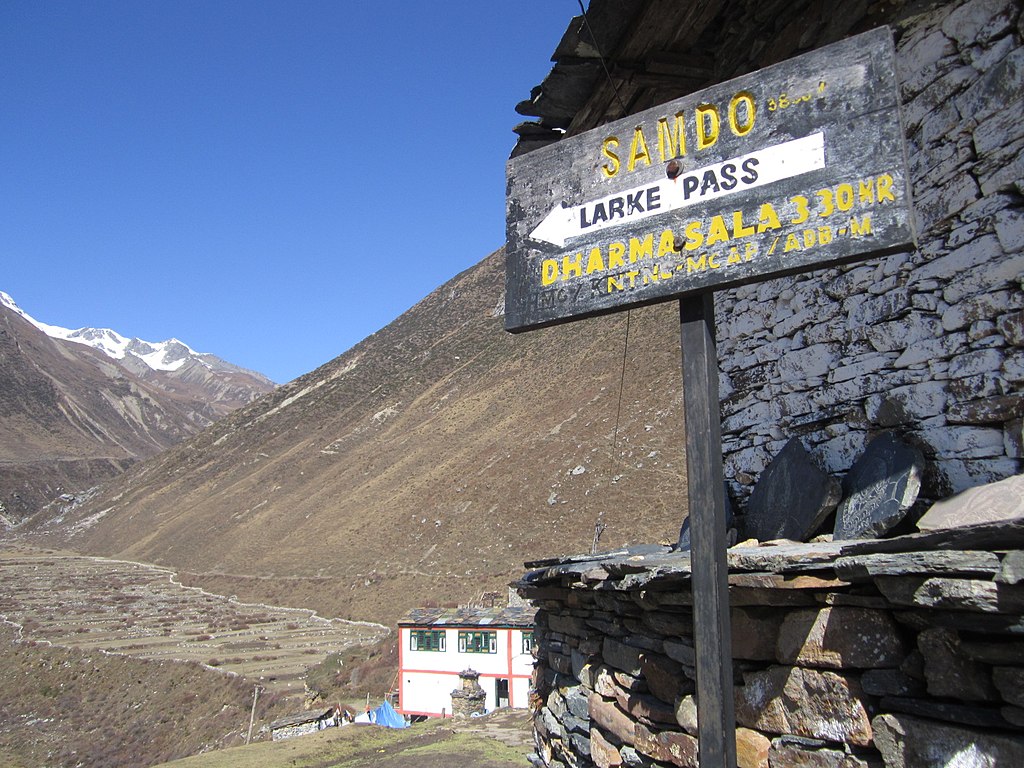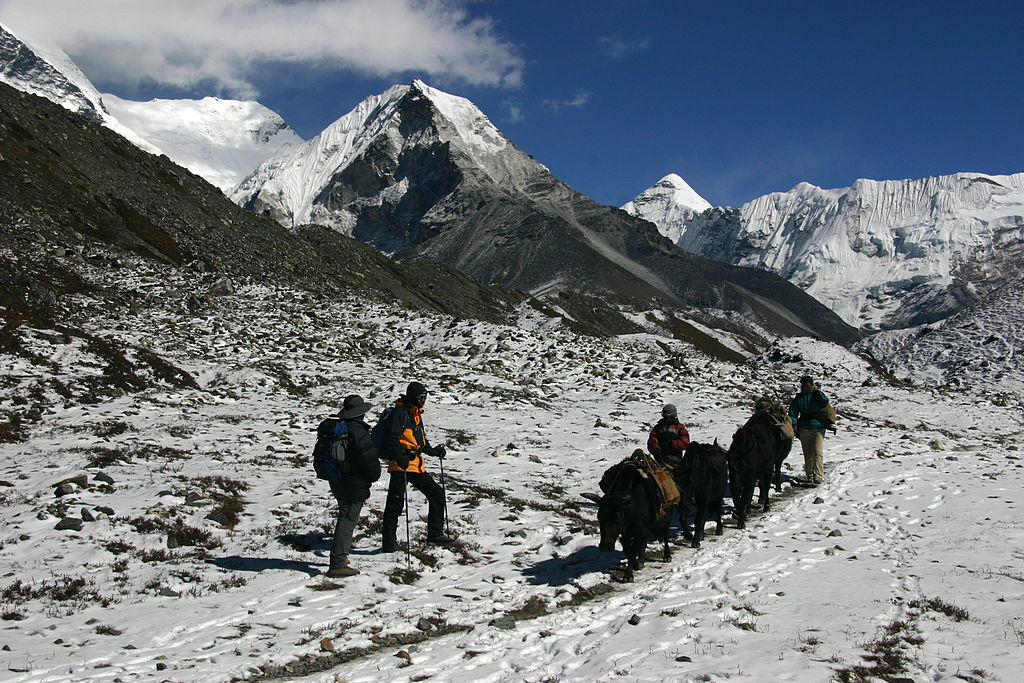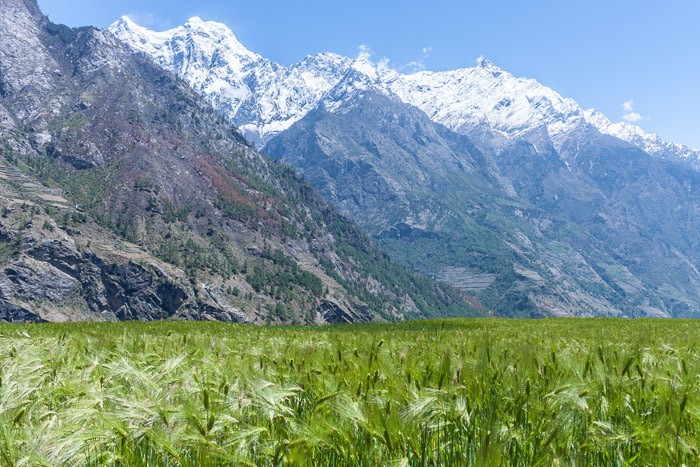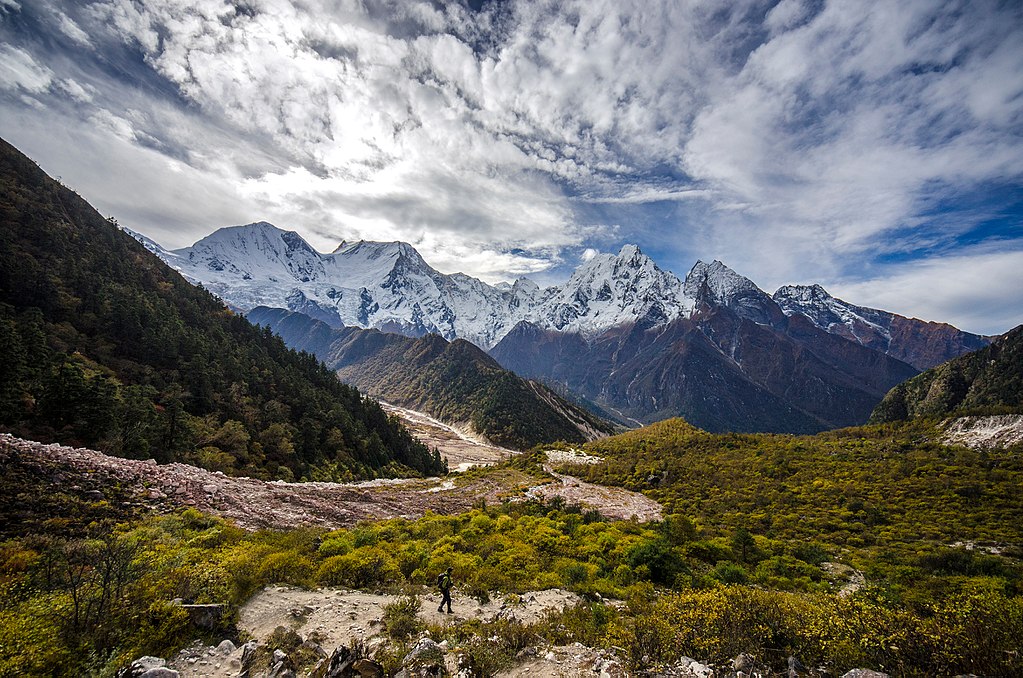Nepal being a geographically diversified country offers trekkers a variety of trekking routes to explore. Manaslu at 8,156 meters (26,759 ft) above sea level, is the eighth highest mountain peak in the world. It is located in the Mansiri Himal, in west-central Nepal. Manaslu meaning “Mountain of the Spirit” was named after the Sanskrit word Manasa meaning “intellect” or “soul.”
Manaslu Larke Pass trek is one of the most adventurous trekking trails in Nepal. It was officially opened as adventure trekking by the government for foreign trekkers in 1991. Since the trek can turn out to be risky sometimes, trekkers should travel in a group of at least two persons with a registered guide rather than independently. Mt. Manaslu is also known as “The Japanese Mountain,” since most climbers who made it up to the summit are Japanese. The trek generally cherishes the mesmerizing mountain scenery along with the local livelihood influenced by Tibetan culture.
Explore Manaslu’s high altitude glacier lakes, a diverse range of flora and fauna and cultural charming region.
Ethnic groups
Mansalu is inhabited by major two ethnic groups; Nurbi and Tsum which are separated by the river at Chhikur. The frequent visit to Nubri occurred since Nepal opened itself for tourism while Tsum still holds on to much of its art, culture, and tradition. The Gurungs dominate the central hills of the region where the Bhutias (also called Bhotias), closed to Sherpas are in the vicinity of Tibet. They are recognized by their flat-roofed houses, monasteries, mani walls, and other Buddhist indicators.
Major Peaks
Apart of Manaslu, there are the region offers the enchanting beauty of other mountains, namely Himachuili (7,893 m.a.s.l), Lango (6,668 m.a.s.l) and Saula (6,235 m.a.s.l).
What makes Manaslu Larke Pass trek route special?
– The mixture of Nepalese and Tibetan culture
– Many suspension bridges as you cross the Buri Gandaki, a long deep river
– Walking between the borders of Nepal and Tibet
– Breathtaking Manaslu range throughout the trekking route
– Ten peaks greater than 6,500 meters (21,300 ft), with a few above 7,000 (23,000 ft) meters in the route
– An ancient monastery “Sama Gompa” at Sama Gaou
– Being wild and remote, the trek manages to facilitate the trekkers with the tea-houses, making the route more accessible for food and accommodation.
– An opportunity to explore a subtropical forest at a lower elevation, Himalayan foothills to the high and challenging crossing of the Larke Pass.
– A wide range of wildlife including endangered animals like snow leopards and red pandas.
– Crossing Larke Pass over 5160 meters
– The best alternative to Annapurna Trek
Getting up to Larke Pass
The trek lies on the newly developed Great Himalayan Trail. The 19 days trek to Manaslu Larke Pass begins from Arughat. Leaving the main road behind at Pokhara, you gear north to Dhading from Kathmandu and join a rough road to its end, reaching Arughat at 550 meters (1,804 feet). The drive is about 8 hours long. The trek continues along the bank of Buri Gandaki reaching Soti Khola at 597meters (1958feet) at 6 hours.
Further 6 hours of the trek and you will be standing on Machha Khola. Climbing over the Machha Khola village and walking past the tobacco and buckwheat fields will lead you to Tatopani village, named after the local hot water springs (called “Tatopani” in Nepali). Off again, walking across the suspension bridge, gentle climb into the woods, passing through the spectacular waterfalls for 7 hours, trekkers arrive at Doban village which will lead to another village called Jagat village at 1,440 meters (3,051 feet).
Further, an easy three to hour hike will lead the trekkers to Samdo at 3,860meters (12,664 feet) which is, in fact, a small collection of houses and lodges. A day hike will rest the trekkers to the Tibet border which will guide them towards the trade route to old Tibet. Passing through the remains of the old market, 2 hours of the steady uphill trail, trekkers arrive in Dharmasala at 4,460 meters (14,628 feet), the last tea house before reaching Larke Pass.
From Dharmasala, the path is not that rough but climbs steadily to reach the top of the pass. The Buddhist flags and Chortens (a Buddhist shrine) further encourage the trekkers to move tirelessly forward while unrevealing the breathtaking scenery from the top. Walking about 8 to 9 hours, here trekkers stand at Larke Pass, the highest point in the Manaslu trek. Larke Pass is also the most exciting and challenging part of the whole trek.
As soon as the trekkers reach Larke Pass, at 5,135 meters (16,847 feet), they are honored with the spectacular view of Mount Himlung, Manaslu North, Annapurna II, and many other snow-covered mountain peaks. The first view of Mount Manaslu from the top is worth every trouble that the trekkers go through during the journey to Larke Pass. The feeling when you are at the top while taking a deep breath in the lap of mountains is just beyond any words can express.
The rest of the journey is proceeding downward from Larke Pass. Trekkers will continue their trek through a different valley. Their trail passes yak pastures and small villages namely Kharche, Gho, and Tilje. Trekking for 8 hours and you reach Dharapani at 1,860 meters(6,102feet). Descending along the Annapurna circuit 7 to 8 hours trek will continue along the Marshyangdi river to Chyamje at 1,430 meters (4,690 feet). Continuing the Annapurna trial for 6 hours, through the Jagat village at 1,440meters (4,724 feet). From Jagat, we take a vehicle to Beishar which takes 4-5 hours. We pass all the way through the banks of Marsyangdi and Trishuli River, enjoying the scenery and refreshing views of the hilly areas and mountains on the way back to Kathmandu.
Trek to Manaslu Tsum valley and take pleasure in a marvelous array of geographical landscapes and cultural diversity.
What can trekkers expect from Larke Pass Trek?
No doubt the trek of Larke Pass is one of the most beautiful treks that will take to the beautiful regions of the Himalayas. In the Larke Pass trek, one can expect to see and experience the following:
-You will pass through the distinctive and remotely located village around Mount Manaslu which is the world’s seventh highest mountain.
-You will get to explore the unique set of cultural diversity of those remote villages. In villages are mainly reside the followers of Buddhism.
– While crossing the Larke Pass, which is at an elevation of 5,125 meters, you will see the most magnificent of the Mount Manaslu.
– Also, you will pass through the paths which offer you a close and splendid view of beautiful snow-capped mountains.
-Along with diving in the pool of natural and scenic beauty, you will enjoy the hospitality and friendliness of the locals in that region.
Flora and Fauna in the Larke Pass region
The region of Larke Pass is rich with different varieties and species of flora and fauna. You can find a wide range of vegetation from tropical riverine forests to tundra vegetation because of the great variation in climate and elevation. There is a tropical hardwood forest of sal, papa lampastti (Duabanga), and Dhusure (Lagerstroemia praviflora). Schima wallichii, Chirepine (pinus roxburghii), Castanopsis indica, Pipal lampastti (Duabanga), Siris (albizia mollis), and others are the vegetation that can be found as you climb towards the higher altitude. Other types of vegetation you can see in the higher altitude areas are juniper (juniperus recurva), fir-birch, rhododendron, and spruce.
In Larke Pass, there is much wildlife that is on the endangered list of species. Looking at the overall wildlife of Manaslu, there are 33 species of mammals, 211 species of butterflies, and 110 species of birds. Monkey, weasel, Langur monkey wild dogs, wild cats, porcupines, ghoral are some of the wildlife in this region.
Samagaun Festival of Larke pass region
Samagaun Festival is celebrated by the people of a small village called Samagaun, which is located at an altitude of about 3,580 meters. This village was damaged in great amounts during the earthquake of April 2015. As of now, most part of the houses in the village has been reconstructed. During this festival, people of this region come together and celebrate it with full joy.
The first expedition to Manaslu Larke Pass
In 1950, H.W. Tilman, with Major J.M.O. Roberts, trekked to Larkey Pass and saw Manaslu and its plateau from there and concluded that there was a direct route to the summit. However, they did not give it a try. After Tilman, the four Japanese expeditions explored the possibility of climbing Manaslu by North and east faces. Finally, on May 09, 1956, Toisho Imanishi and Gyalzen, members of a Japanese expedition, climbed Manaslu for the first time in history.
When to explore Larke Pass?
Manaslu is one of the riskiest mountains to climb. It is commonly known as “The Killer Mountain” because of its toughness during the climbing. In May 2008, 297 conquests of the mountain were made out of which 53 deaths occurred in the mountains. Planning trekking for Larke Pass would be more effective in spring (March to May) and autumn (Mid Sep to November). This time is the least hazardous for bad weather, snowfall, rainfall, and avalanches. December also offers the best moment of your life with crystal clear views, but the cold temperature is not something everyone can stand. However, trekkers should not forget to start their trek early to avoid the unusual wind that increases later in the day.
Is it safe to trek to Manaslu Larke Pass after the 2015 Earthquake in Nepal?
The earthquake in 2015 posed severe damage in Gorkha, a district under which the Manaslu circuit falls. The earthquake caused transformations in trekking trials. Still, many trekkers wonder whether it is safe to trek to Manaslu. In spite of the rumors after the earthquake, trekkers are still doing tasteful treks. The trek routes are achievable, and the tea house is in good condition. So, there is nothing to worry about.
Have any queries about Manaslu Larke Pass Trek?
Altitude sickness and Medical help
Altitude sickness is a serious problem as you proceed toward higher altitudes. It results when your body fails to adopt the pressure drop and less oxygen at higher elevations and can affect anyone, regardless of age or fitness. Usually, altitude sickness occurs above 2,500 meters. A headache, nausea, vomiting, fatigue, loss of energy, less appetite, and problems with sleep are some of the symptoms of Altitude Sickness. More serious conditions may include the inability to walk, shortness of breath even at rest, and a cough that produces a white or frothy pink substance.
The more altitude you reach, the riskier it becomes. Thus once you reach 3,500 meters, you have to be careful that you do not climb more than 300-400 meters a day. The only cure for altitude sickness is to descend to a lower altitude. If you suffer altitude sickness, the best idea will be to consult your guide to go down at least 500 meters to recover. Nepal Sanctuary Treks is here to develop a very well-staged itinerary for acclimatization.
Pack your bag with
– Water bottle (preferably the one which keeps the water warm)
– Cameras with extra batteries
– Sunscreen cream
– Sunglasses
– Trekking stick
– Raincoat
– T-shirts
– Wind stopper and down jacket
– Thermal tops and bottom
– Trekking trousers
– Trekking boots and sandals
– Socks, Gloves, Woolen cap
– First aid kit
– Dry foods, chocolates, or energy bars












